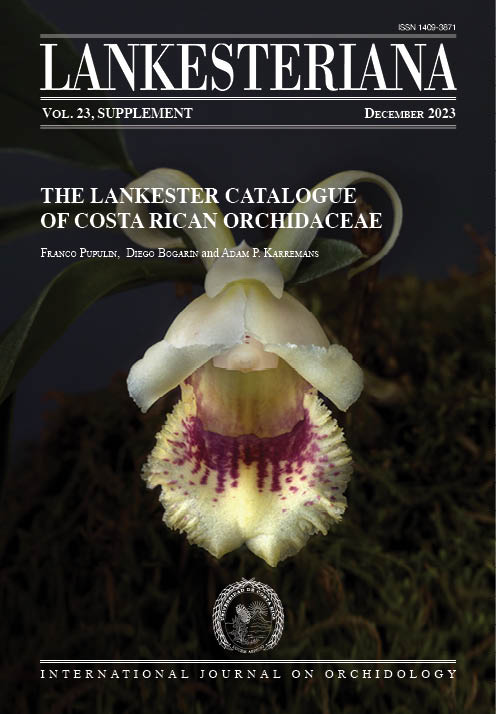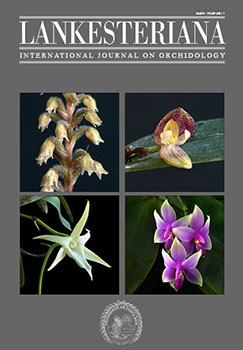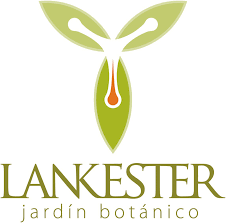THE LANKESTER CATALOGUE OF COSTA RICAN ORCHIDACEAE
DOI:
https://doi.org/10.15517/lank.v23iSupplement.58145Palabras clave:
biodiversidad, lista anotada, Neotrópico, orquídeas de Costa RicaResumen
Este estudio presenta un catálogo completo actualizado de la flora de orquídeas de Costa Rica. Hemos documentado 1684 especies, cuatro subespecies, 14 híbridos naturales y siete formas en 201 géneros y dos nothogéneros, × Bensteinia y × Cochlezella. Todas las subfamilias de Orchidaceae están representadas, excepto Apostasioideae. La subtribu Pleurothallidinae representa aproximadamente el 35% de todas las especies, seguida de Laeliinae (20%) y Oncidiinae (+12%). Los géneros más ricos en especies en Costa Rica son Epidendrum (245 spp.), Lepanthes (163 spp.), Stelis (109 spp.) y Pleurothallis (63 spp.). Aproximadamente el 30% de todas las especies son endémicas, principalmente concentradas en Lepanthes (109 spp. = 67%), Epidendrum (76 spp. = 31%), Stelis (40 spp. = 37%), Telipogon (35 spp. = 88%), y Pleurothallis (31 spp. = 46%). Todas las especies están respaldadas por ejemplares almacenados en herbarios públicos importantes, incluyendo CR, JBL y USJ en Costa Rica, así como AMES, K, SEL, US y W, a nivel internacional, entre otros. El catálogo incluye 5300 nombres de orquídeas en los rangos específicos y subespecíficos, casi el 70% de los cuales se tratan como sinónimos. El nuevo catálogo presenta un aumento de 324 especies en comparación con su predecesor, publicado hace veinte años, un aumento neto de casi 24%. El aumento en la riqueza registrada de la flora de orquídeas de Costa Rica se atribuye principalmente al descubrimiento de especies nuevas para la ciencia y en menor medida, a taxones recién registrados para el país como resultado de las exploraciones sistemáticas realizadas en el país durante el presente siglo. Se presenta un esquema filogenético de los géneros registrados en Costa Rica, desde el rango de subfamilia hasta el de subtribu, incluyendo una sinopsis de la diversidad registrada para cada género. También se proporciona una lista enumerada de las especies aceptadas y un índice completo de nombres aceptados y sinónimos. Éste índice enlaza la lista anotada de especies y el catálogo principal. Se proponen nuevas combinaciones para Andreettaea fimbriata y Camaridium muscoides. Se incluyen fotografías de especies representativas de la mayoría de los géneros basadas en ejemplares de Costa Rica. Esperamos que este catálogo inspire la investigación orquideológica y botánica en Costa Rica y otras regiones neotropicales, lo que llevará a descubrimientos adicionales en los próximos años.
Descargas
Citas
Ames, O. (1922). Orchidaceae quaedam Americanae. Schedulae Orchidianae, 1, 1–24.
Bogarín, D., Karremans, A., & Pupulin, F. (2008). New species and records of Orchidaceae from Costa Rica. Lankesteriana: International Journal on Orchidology, 8(2), 53–74. https://doi.org/10.15517/lank.v0i0.7927
Bogarín, D. (2011). How many orchid species in Costa Rica? A review of the latest discoveries. In: A. M. Pridgeon & H. G. Navarrete Zambrano (Eds.), Proceedings of the Third Scientific Conference on Andean Orchids, Quito. (pp. 185–205). Lankesteriana: International Journal on Orchidology, 11(3), 185–205.
Bogarín, D. & Pupulin, F. (2021). The orchid flora of Barra Honda National Park, Nicoya, Guanacaste, Costa Rica. Harvard Papers in Botany, 26(1), 7–99.
Bogarín, D., Pupulin, F., Arrocha, C., & Warner, J. (2013). Orchids without borders: studying the hotspot of Costa Rica and Panama. Lankesteriana: International Journal on Orchidology, 13(1–2). https://doi.org/10.15517/lank.v0i0.11529 Bogarín, D., Serracín, Z., Samudio, Z., Rincón, R., & Pupulin, F. (2015). An updated checklist of the Orchidaceae of Panamá.
Lankesteriana: International Journal on Orchidology, 14(3), 135–364. https://doi.org/10.15517/lank.v14i3.17958
Dressler, R. L. (2003). Orchidaceae. In: B. E. Hammel, M. H. Grayum, C. Herrera & N. Zamora (Eds.), Manual de Plantas de Costa Rica. Volumen III. Monocotiledóneas Orchidaceae–Zingiberaceae. Monographs in Systematic Botany from the Missouri Botanical Garden, 93, 1–595.
Fernández, M., Karremans, A. P., & Jiménez, D. (2014). New species and records of Orchidaceae from Costa Rica. III.
Lankesteriana: International Journal on Orchidology, 13(3), 259–282. https://doi.org/10.15517/lank.v13i3.14363
Gu, Z., Gu, L., Eils, R., Schlesner, M., & Brors, B. (2014). Circlize implements and enhances circular visualization in R.
Bioinformatics, 30, 2811–2812.
Kalyaanamoorthy, S., Minh, B.Q., Wong, T. K. F., von Haeseler, A. & Jermiin, L.S. (2017). ModelFinder: fast model selection for accurate phylogenetic estimates. Nature Methods, 14, 587–589.
Karremans, A.P. (2021). With great biodiversity comes great responsibility: the underestimated diversity of Epidendrum
(Orchidaceae). Harvard Papers in Botany, 26(2), 299–369. https://doi.org/10.3100/hpib.v26iss2.2021.n1
Karremans, A.P. (2022). Epistephium Kunth. In: F. Pupulin & collaborators (Eds.), Vanishing Beauty: native Costa Rica orchids. Vol. 3. Restrepia–Zootrophion and Appendices (pp. 1410–1411). Oberreifenberg, Germany: Koeltz Botanical Books.
Karremans, A.P., Bogarín, D., Fernández, M, Smith, C. M. & Blanco, M. A. (2012). New species and records of Orchida- ceae from Costa Rica. II. Lankesteriana: International Journal on Orchidology, 12(1), 19–51.
Karremans, A.P., Bakker, F.T., Pupulin, F., Solano-Gomez, R. & Smulders, M.J.M. (2013). Phylogenetics of Stelis and closely related genera (Orchidaceae: Pleurothallidinae). Plant Systematics and Evolution, 29(1), 69–86.
Katoh, K., & Standley, D.M. (2013). MAFFT Multiple Sequence Alignment Software Version 7: Improvements in Performance and Usability. Molecular Biology and Evolution, 30, 772–780.
Hunter, J. D. (2007). Matplotlib: A 2D graphics environment. Computing in Science & Engineering, 9(3), 90–95. McKinney, W. (2011). Pandas: powerful Python data analysis toolkit. https://pandas.pydata.org.
Nguyen, L.-T., H. A. Schmidt, A. von Haeseler, and B. Q. Minh. 2015. IQ-TREE: A Fast and Effective Stochastic Algorithm for Estimating Maximum-Likelihood Phylogenies. Molecular Biology and Evolution, 32, 268–274.
Ossenbach, C., Pupulin, F. & Dressler, R. L. (2007). Orquídeas del istmo centroamericano: catalogo y estado de conserva- cion/Checklist and conservation status: Orchids of the Central American isthmus. Editorial 25 de Mayo, Sabanilla de Montes de Oca, San José, Costa Rica.
Ossenbach C. (2009). Orchids and orchidology in Central America. 500 years of history. Lankesteriana: International Journal on Orchidology, 9(1–2), 1–268.
Pérez-Escobar, O. A., Bogarín, D., Przelomska, N. A. S., Ackerman, J. D., Balbuena, J. A., Bellot, S., Bühlmann, R. P., Cabrera, B., Cano, J. A., Charitonidou, M., Chomicki, G., Clements, M. A., Cribb, P., Fernández, M., Flanagan, N. S.,
Gravendeel, B., Hágsater, E., Halley, J. M., Hu, A.-Q., … Antonelli, A. (2023). The origin and speciation of orchids.
BioRxiv, 2023.09.10.556973. https://doi.org/10.1101/2023.09.10.556973
Pérez-Escobar, O. A., Chomicki, G., Condamine, F. L., Karremans, A. P., Bogarín, D., Matzke, N. J., Silvestro, D. & Antonelli,
A. (2017). Recent origin and rapid speciation of Neotropical orchids in the world’s richest plant biodiversity hotspot. New Phytologist, 215, 891–905.
Pérez-Escobar, O. A., Dodsworth, S., Bogarín, D., Bellot, S., Balbuena, J. A., Schley, R. J., Kikuchi, I. A., Morris, S. K., Epitawalage, N., Cowan, R., Maurin, O., Zuntini, A., Arias, T., Serna-Sánchez, A., Gravendeel, B., Torres Jimenez, M. F., Nargar, K., Chomicki, G., Chase, M. W., Leitch, I. J., Forrest, F., & Baker, W. J. (2021). Hundreds of nuclear and plastid loci yield novel insights into orchid relationships. American Journal of Botany, 108(7), 1166–1180. https://doi. org/10.1002/ajb2.1702
Pridgeon, A. M., Cribb, P. J., Chase, M. W. & Rasmussen, F. (1999). Genera Orchidacearum. Volume 1. Apostasioideae and Cypripedioideae. Oxford, Oxford University Press.
Pridgeon, A. M., Cribb, P. J., Chase, M. W. & Rasmussen, F. (2001). Genera Orchidacearum. Volume 2. Orchidoideae (Part one). Oxford, Oxford University Press.
Pridgeon, A. M., Cribb, P. J., Chase, M. W. & Rasmussen, F. (2003). Genera Orchidacearum. Volume 3. Orchidoideae (Part 2). Vanilloideae. Oxford, Oxford University Press.
Pridgeon, A. M., Cribb, P. J., Chase, M. W. & Rasmussen, F. (2005). Genera Orchidacearum. Volume 4. Epidendroideae (Part one). Oxford, Oxford University Press.
Pridgeon, A. M., Cribb, P. J., Chase, M. W. & Rasmussen, F. (2009). Genera Orchidacearum. Volume 5. Epidendroideae (Part two). Oxford, Oxford University Press.
Pridgeon, A. M., Cribb, P. J., Chase, M. W. & Rasmussen, F. (2014). Genera Orchidacearum. Volume 6: Epidendroideae (Part three). Oxford, Oxford University Press.
Pupulin, F. (1988). Orchid florula of Parque Nacional Manuel Antonio, Quepos, Costa Rica. Revista de Biologia Tropical, 46(4), 961–1031.
Pupulin, F. (2002). Catálogo revisado y anotado de las Orchidaceae de Costa Rica. Lankesteriana: International Journal on Orchidology, 4, 1–88.
Pupulin, F. (2022). Inexhaustable diversity. In: F. Pupulin & collaborators (Eds.), Vanishing Beauty: native Costa Rica orchids. Vol. 3. Restrepia–Zootrophion and Appendices (pp. vii–xv). Oberreifenberg, Germany: Koeltz Botanical Books.
Pupulin, F. & Bogarín, D. (2018). Orchids of paradise. Exploring the lower Talamanca Sashores of Costa Rica, the “Coast of Plenty” of Columbus. Orchids (American Orchid Society Bulletin), 87, 846–857.
Pupulin, F & Karremans, A.P. (2017). Horichia dressleri. A new genus recorded for Costa Rica and a truly rare orchid?
Lindleyana in Orchids (Bull. Amer. Orch. Soc.), 86(8), 610–617.
Pupulin. F. & Karremans, A.P. (2022). Spathoglottis Blume. In: F. Pupulin & collaborators (Eds.), Vanishing Beauty: native Costa Rica orchids. Vol. 3. Restrepia–Zootrophion and Appendices (pp. 1114–1115). Oberreifenberg, Germany: Koeltz Botanical Books.
R Core Team (2023). R: A language and environment for statistical computing. R Foundation for Statistical Computing, Vienna, Austria. ISBN 3-900051-07-0. Retrieved from http://www.R-project.org/
Reichenbach, H.G. (1866). Beitrage zu einer orchideenkunde Central-Amerika’s. Hamburg. T.G. Meissner, p. 97. Schlechter, F.R.R. (1921). Orchidaceae novae et criticae. Decas LXIX. Additamenta ad Orchideologiam Central-
Americanam. Repertorium Specierum Novarum Regni Vegetabilis Beihefte, 17(481–485), 138–144.
Garnier, S., Ross, N., Rudis, R., Camargo, A.P., Sciaini, M., & Scherer, S. (2023). Viridis(Lite) - Colorblind-Friendly Color Maps for R. viridis package version 0.6.4.
Ulloa Ulloa, C., Hernández, H. M., Davidse, G., Barrie, F. R., Knapp, S., & Dressler, R. (2023). Flora Mesoamericana, Vol 7, Parte 2: Orchidaceae. Universidad Nacional Autónoma de México, Missouri Botanical Garden Press, and the Natural History Museum (London).
Van Rossum, G., & Drake, F. L. (2009). Python 3 Reference Manual. Scotts Valley, CA: CreateSpace.
Waskom, M. (2021). Seaborn: statistical data visualization. The Journal of Open Source Software, 6(60), 3021. https://doi. org/10.21105/joss.03021
Wickham, H. (2016). ggplot2: Elegant Graphics for Data Analysis. Springer-Verlag New York. ISBN 978-3-319-24277-4, https://ggplot2.tidyverse.org.
Wickham, H., François, R., Henry, L., Müller, K., & Vaughan, D. (2023). dplyr: A Grammar of Data Manipulation. https:// dplyr.tidyverse.org, https://github.com/tidyverse/dplyr.

Descargas
Publicado
Cómo citar
Número
Sección
Licencia
Derechos de autor 2023 Jardín Botánico Lankester, Universidad de Costa Rica

Esta obra está bajo una licencia internacional Creative Commons Reconocimiento-NoComercial-SinObraDerivada 3.0.
Conforme con las Políticas de Acceso Abierto promovidas por la Universidad de Costa Rica, los derechos de autor de todos los artículos publicados en Lankesteriana se encuentran bajo una licencia Creative Commons y pueden ser descargados gratuitamente. Los derechos de autor y de publicación pertenecen a la revista bajo la licencia CC BY-NC-ND 3.0 CR.
Before the publication of the materials submitted by the author(s) in LANKESTERIANA, the author(s) hereby assign all rights in the article to the Lankester Botanical Garden.




